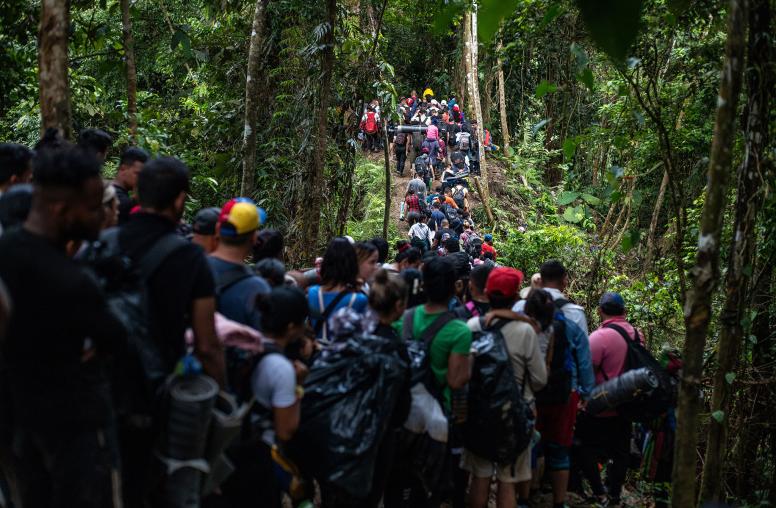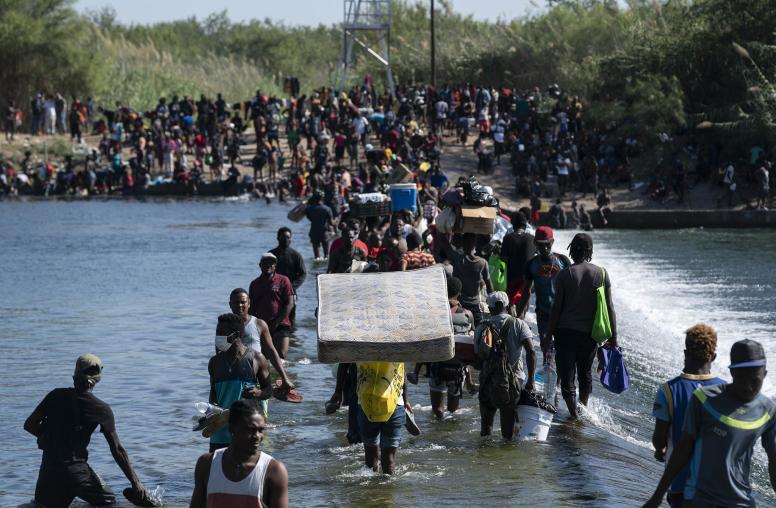From How to Who: Reforming the Civilian Workforce for Prevention
Prioritizing preventing extremism in fragile states requires new approaches to empower diplomats and development officers.
Editor’s Note: Congress charged the U.S. Institute of Peace with convening the Task Force on Extremism in Fragile States. Following the public launch of the Task Force’s final report, four groups of experts came together to discuss how to implement the report’s recommendations. This four-part series discusses the findings from these strategy sessions. Part three summarizes expert discussion on the report’s recommendations on reforming the civilian workforce to empower diplomats and developments practitioners in the field to achieve long-term prevention goals.

It seems obvious that a U.S. foreign service or development officer would need a unique set of skills for dealing with the varied challenges they face in fragile countries. Delivering humanitarian assistance effectively in the wake of a natural disaster requires a mentality and approach that is different from advising a government in a fragile state facing mass unrest. But, the civilian workforce of the U.S government isn’t always equipped to perform the roles that policymakers require of them. Similarly, preventing conflict or extremism in countries where the United States has diplomatic missions requires a different way of operating—it may even require a different workforce altogether.
Some experts worry that the challenge goes even deeper than workforce reform. They suggest it has more to do with America’s risk-averse culture, which, in practice, has meant security and other restrictions on government personnel that hamper travel within conflict-affected states. This is detrimental for the implementation of preventive strategies in vulnerable communities.
Much of the debate about the U.S.’s ability to implement a more effective approach to prevention focuses on three issues:
- Whether the civilian workforce lacks skills for prevention;
- Whether foreign service officers have the personal profile to succeed in prevention roles; and
- Whether these workers have the structural and career incentives to apply their talents to prevention.
Each of these questions is rooted in a slightly different understanding of what it means for the United States to engage in prevention, and each one leads to a different set of policy conclusions, namely the:
- Creation of a cadre of dedicated, full-time professionals;
- Establishment of an “expeditionary” reserve force; or
- Overhaul of existing recruitment, training, promotion, and retention policies.
The Who of the How: Fundamentals for Prevention and Workforce Requirements
Prevention is difficult in states and societies that lack the political will to institute the reforms that are often necessary to address grievances that, when exploited by extremist ideologies, can become threats to stability. But finding those leaders and helping to catalyze the reforms they seek requires engaging a broad range of actors outside of capital cities including among provincial governments, municipalities, community leaders, business owners, civil society, and nongovernmental organizations, as well as women, youth, religious leaders, and others. It also requires understanding social fault lines and political grievances, being able to read local power dynamics and, perhaps most importantly, the willingness and ability to sustain this sort of engagement for far longer than the average diplomatic tour permits.
Consider the National Resources Counterinsurgency Cell (NRCC), a program in Afghanistan that sent U.S. civilians, paired with military units, into remote, contested areas of the country with the goal of identifying and working with village leaders whom the Taliban might seek to recruit. The NRCC program sought to empower these village leaders to gain peacefully the status and resources that the Taliban offered them through violence. This program encouraged key U.S. civilians with needed expertise and skills to work in areas that diplomats rarely visit and develop relationships and programs that were much more personal, specific, and political than traditional development projects.
While the NRCC program itself was short-lived, such prevention efforts need to be sustained for long periods of time if they are to foster meaningful results. U.S. personnel assigned to craft and implement preventive strategies along with partners might, therefore, also be expected to undertake longer, more mission-focused assignments than currently the norm.
Depending on which is stressed as the most important to prevention—conflict and political analysis skills, ability to form relationships with local communities over sustained deployments, or willingness to take on repeated prevention-focused assignments—leads to different diagnoses of what is lacking in the current civilian workforce and how to upgrade it. There is widespread agreement, however, that any preventive programming requires U.S. personnel getting out “beyond the wire” and into local communities. The first step, therefore, is overcoming the U.S. bureaucracy’s risk-averse posture.
The Risks of Risk Aversion
For prevention efforts to work, U.S. civilians must get outside the security provided by embassy compounds and capital cities. Current security practices, while well intentioned and designed to protect American lives, significantly hamper the ability to do important work. Policymakers need to acknowledge the trade-offs between the risks to personnel and the risks of program ineffectiveness. Securing the objectives of U.S. policy, especially in fragile states, requires accepting greater risks to our personnel.
Allowing U.S. civilian personnel greater leeway to work in the field, however, does not mean accepting undue risks. Instead, it requires adopting new ways of managing those risks. One promising example is the way in which the Syria Transition Assistance Response Team—working in parts of Syria liberated from ISIS—was able to rely on security provided by the U.S. military. Providing diplomatic security training to diplomats and development officers working in fragile contexts would be a first step in empowering personnel for managing risk. Involving Congress in risk management discussions in advance is also important.
Despite the consensus over the need for greater risk tolerance when pursuing prevention goals, the question of what else civilian personnel need to carry out their work effectively is still open.
The Skills Gap
One answer to this question is that a different skillset is needed than what current State Department and USAID personnel are trained on. Rather than the current division between consular, economic, management, political, and public diplomacy tracks in the foreign service, prevention requires skills that cut across all these fields and others. These include:
- Conflict analysis;
- Identification and analysis of the sources of resilience and the opportunities to promote and strengthen them in national government, local communities, and civil society;
- Fostering of rule of law; and
- Partnership development.
Because addressing state fragility and the prevention of violent extremism has not been a priority of U.S. foreign policy, these skills have not been packaged into a single toolbox nor have personnel been trained or supported in a systematic way to operate in expeditionary roles and to implement prevention strategies along with partners.
The remedy suggested by many observers is the creation of a dedicated cohort of full-time professionals trained in prevention and located somewhere within the diplomatic or development apparatus. This model resembles the original idea behind the Civilian Response Corps and would function somewhat like the existing Disaster Assistance Relief Teams (DART) or conflict experts at State and USAID but on a larger scale.
However, it is important to distinguish this proposal from existing models that are largely reactive in nature—meaning civilian personnel are not sent in until disaster or conflict has struck and only rarely are they on the ground for prolonged periods. Deployable prevention professionals would be sent to assist at-risk countries for as long as it takes to build up their resilience. Creating such a dedicated preventive service could both protect State and USAID from mission creep while institutionalizing prevention as a core national security function.
Personal and Career Profiles for Prevention
Prevention work requires not just training and skills but certain personal and professional characteristics. A desire for longer deployments, preference for more time in the field, greater ability to adapt to local conditions, and less interest in career advancement might be prerequisites for individuals to be more successful in fragile states. Attracting individuals with these specific preferences to government service could require recruiting outside the standard pool of applicants
Capitalizing on talented individuals who might be willing to undertake preventive assignments but not a full-fledged career in public service could require establishing an expeditionary reserve force. Rather than being full-time employees of the U.S. government, prevention personnel could be called upon as needed and, upon completion of their mission, return to their profession outside the federal government. This would allow for a larger pool of personnel to draw on, potentially with a wider range of expertise and experiences, and at a far lower cost than maintaining a standing civilian service of equivalent size.
Incentivizing Careers Focused on Prevention
Finally, while people with the right skills and talents are already present in the workforce, they are hampered from utilizing and developing their abilities either by lack of opportunities or by career paths that do not reward prevention assignments. Rarely do policymakers in Washington or chiefs of missions in fragile states direct their personnel to engage in activities that are adaptive, context-dependent, conflict-sensitive, and partner-focused. Relatedly, because career advancement is not necessarily tied to specialization, longer deployments, or certain types of expertise, America’s diplomats and development professionals have little incentive to develop their talents and the skills needed to design and implement preventive strategies.
If the problem is indeed one of career opportunities and incentives, then perhaps State Department and USAID personnel policies need to be reevaluated and overhauled. It might not be a matter of just training or recruiting new personnel, but rather of making it clear that foreign service and development officers that work in prevention will have the same opportunities to earn promotions and raises as their peers who follow more traditional assignments and career paths. When looked at from this perspective, perhaps the biggest obstacle facing the State Department—one that USAID is beginning to address with its ongoing reorganization—is the division between regional bureaus and functional areas, with lack of clarity about who sets policy and how it gets implemented. The sorts of changes envisioned by proponents of this approach require not only political will but time to take effect.
The federal civilian workforce’s limitations are worthy of further, and far more detailed, investigation. If prevention is to become a national security priority for the United States, policymakers should invest in and empower the talented and courageous civilian professionals who will be called upon, and will volunteer, to take up this vital mission.
Blaise Misztal was the executive director of the Task Force on Extremism in Fragile States and currently a fellow at the Hudson Institute. Eric Brown is a senior fellow at the Hudson Institute. For more, see:


